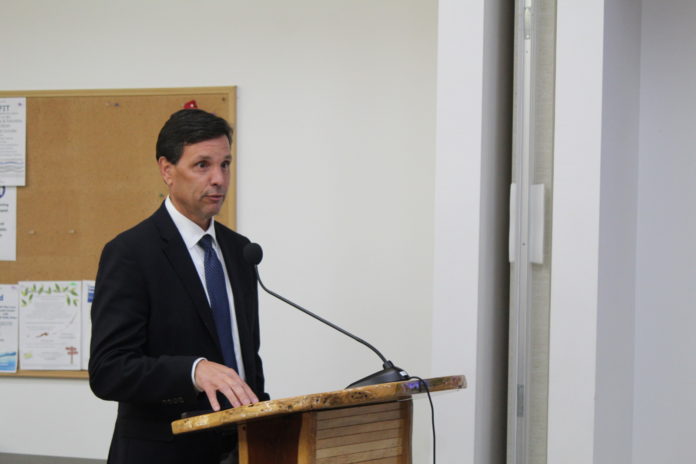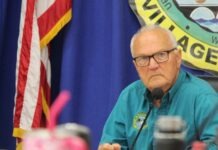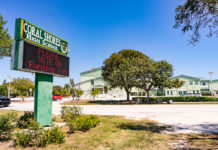A room full of concerned village residents awaiting a building permit packed the Founders Park Community Center during a June 16 special meeting of the Islamorada Village Council. The discussion delved into the village’s Building Permit Allocation System, or BPAS, a point-based competitive system for issuing building permits.
Seventy-nine applications requesting a building permit are in the queue, Planning Director Dan Gulizio said as he stood before the gallery and the dais to provide a thorough presentation on BPAS, the history, the issues and the next steps. The problem? The village doesn’t have 79 allocations to offer.
Even more significant than the applications awaiting a permit is the number of vacant parcels out there in the village that could be developed, do not have a permit and are not in the BPAS system.
Gulizio’s presentation brought various highlights.
STATE MANDATES TO RESTRICT GROWTH
In 1974, the Florida legislature designated the Florida Keys an area of critical state concern. Per law, the legislature had the ability to designate certain areas that contain resources of statewide significance. It included the village of Islamorada. As a result, Gulizio said the state imposed mandates on the village to manage development through its comprehensive plan and land development regulations.
“That all stems from state law. These aren’t rules or guidelines that the council created or the previous council created,” he said.
Not only was it created for a safe hurricane evacuation, it also set out to protect natural resources and nearshore water quality of the Keys, conserve and promote community character, provide affordable housing in proximity to jobs and protect constitutional rights of property owners.
ISLAMORADA’S POPULATION EXPLODES
Per Gulizio, there are almost six times as many people living in Islamorada now compared to 50 years ago – from 1,200 to 7,100, from 1970 to 2022. Gulizio said that increase is consistent with Monroe County and Florida.
As for population density, Gulizio said the village has 1,102 people per square mile. In Monroe County, there are 74.3 people per square mile. In Florida, there are 406 people per square mile.
“If Islamorada was a state, it would be the second densest state in the country,” Gulizio said.
As for water supply, Gulizio said the village is pumping 500,000 more gallons of water over the last year. Metered water is about 700 million and the actual water is 900 million gallons. “That difference is leaking of the pipes,” Gulizio said. “Essentially the system is not that efficient; we lose a lot through leakage and we lose a lot when pipes are being worked on through construction and additions to the system when they’re being flushed. That’s about 28% of water that’s lost. Speaking to Florida Keys Aqueduct Authority, that is an industry standard that’s pretty consistent.”
ISLAMORADA GOES TO BPAS
In 2002, the village moved from Monroe County’s Rate of Growth Ordinance (ROGO) program to a building permit allocation system (BPAS). At that time, the state provided 302 building allocations for the lifetime of the program, of which 171 were market rate housing and 131 affordable housing.
In 2004, allocations increased from 302 to 565, based on new traffic modeling by the state. In addition, the percentage of allocations for market rate and affordable were nearly equalized, 51% to 49% respectively.
In 2007, there was yet another change. While total allocations stayed the same at 565, the allocation ratio changed again, to 71% market rate and 29% affordable.
“The way to look at that today is that would be the difference of 112 new affordable housing units that we otherwise don’t have right now. At the time, there wasn’t quite the demand in 2007 that there is today for the crisis we are having for affordable housing. I’m not questioning that judgment of that change. I’m just pointing out there are consequences for those changes,” Gulizio said.
So far, Gulizio said 533 building permit allocations were issued, with 381 going to market rate housing and 152 for affordable housing.
LAND DEDICATIONS
Last meeting, concerns arose over allocations with or without land dedication. Council allowed the granting of a maximum of six allocations with land dedications on an annual basis. The council granted two in 2021 and two in 2022. During the lifetime of the program, 12 applications were authorized with a land dedication.
ADMINISTRATIVE RELIEF
Those who went through the BPAS for at least four years, complied with the program and still don’t have an allocation can petition the council for what’s known as administrative relief. Gulizio said the council can grant the application and give credit to develop the property. The council can also buy the property at fair market value, or can suggest “such other relief as may be necessary and appropriate.”
AFFORDABLE HOUSING GOALS
Per Gulizio, village code requires 30% of the generated local workforce be provided with an affordable housing unit. Gulizio said there are different estimates of the local workforce total. According to Monroe County, there are about 3,500 total employees. The Islamorada Chamber of Commerce estimates 5,500 employees. That would equate to 1,650 affordable housing units.
Per the comprehensive plan, there should be a minimum 1,192 affordable housing units. To date, the village has established 151 total affordable housing units, of which 126 have conditions to be affordable in perpetuity and 25 with sunset provisions.
“Affordable housing is a component of BPAS and is intertwined as a critical need in our comprehensive plan,” Gulizio said.
This year, the village was awarded 22 building permit allocations, of which 10 are for affordable housing. Next year, the village will get 11 allocations, with five of them for affordable housing.
VACANT PRIVATE PARCEL ANALYSIS
There are 970 private vacant parcels in the village, totaling 785 acres. Breaking it down by zoning district, almost half of the 785 acres, 385 acres, are located within the village’s conservation district. There are also 258 habitat acres that are regulated through the area of state critical concern designation.
“95% of privately held land has either been developed or otherwise impacted by some environmental constraint,” he said.
There are roughly 117 acres in the residential estate district with 59 development credits and 111 acres in the residential single-family district equating to 1,071 development credits.
POLICY OPTIONS
One option Gulizio presented was the ability for the village to purchase development rights. It’s something other municipalities do, and Gulizio said it’s also recommended per the village’s code and comprehensive plan. Gulizio said the village and partners, such as the state, should purchase development rights of environmentally sensitive land.
“Since this is an area of critical state concern, and it’s a regional state resource and the tourist economy is a state resource and benefit, it would be nice if the state would again work in partnership with the village to address part of the need to help better preserve some of the critically, environmentally sensitive areas that make this place special,” he said.
Another regulatory approach Gulizio outlined is looking at how much density the village allows under current zoning. “The idea that we would allow in our single residential, low density future land use map designation 10 units per acre doesn’t make a lot of sense from a policy standpoint,” he said. “To me, there’s a mismatch between what our zoning promotes and what our comprehensive plan goals are and what the goals ultimately are of the ACSC. And that’s something we can revisit and something we should revisit.”
Gulizio said he’s taking questions about being more flexible with transfer development rights. Gulizio said the village has a “Byzantine set of requirements on where people can transfer based on zoning.” Gulizio said the village should not only think about transferring them within the village, but should also think about transferring in other Keys communities with their support and outside the Keys community with participation and support of state legislators.
There’s also the ability to extend the length of BPAS (not the number of allocations, but the timeframe to issue those allocations) to 2025 or 2026. “We have a window of opportunity now to tackle these issues. If we’re getting toward the end of the window and we don’t have all of our analysis done and we don’t have all our solutions in place, I think that’s something we can put on the table and discuss,” Gulizio said.
“I think the state has a fundamental responsibility and obligation to help address these concerns and challenges we’re facing in terms of the volume of development credits on the books and amount of allocations we have remaining,” Gulizio continued.
NEXT STEPS
Gulizio said staff will continue the vacant parcel analysis, meet with surrounding communities to discuss their challenges and seek alternatives. He also acknowledged that the village should amend its code to to free up transfer development rights to be used in other areas not only in the village, but the Keys and communities outside the Keys.
Gulizio will report back in 45 to 60 days with additional updates. No official action was taken by the village council during the June 16 meeting.


























